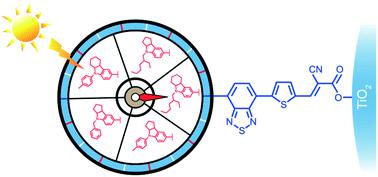当前位置:
X-MOL 学术
›
Mol. Syst. Des. Eng.
›
论文详情
Our official English website, www.x-mol.net, welcomes your feedback! (Note: you will need to create a separate account there.)
Structural features of indoline donors in D–A-π-A type organic sensitizers for dye-sensitized solar cells
Molecular Systems Design & Engineering ( IF 3.6 ) Pub Date : 2021-07-05 , DOI: 10.1039/d1me00054c Ellie Tanaka 1 , Maxim S. Mikhailov 2 , Nikita S. Gudim 3 , Ekaterina A. Knyazeva 2, 3 , Ludmila V. Mikhalchenko 3 , Neil Robertson 1 , Oleg A. Rakitin 2, 3
Molecular Systems Design & Engineering ( IF 3.6 ) Pub Date : 2021-07-05 , DOI: 10.1039/d1me00054c Ellie Tanaka 1 , Maxim S. Mikhailov 2 , Nikita S. Gudim 3 , Ekaterina A. Knyazeva 2, 3 , Ludmila V. Mikhalchenko 3 , Neil Robertson 1 , Oleg A. Rakitin 2, 3
Affiliation

|
We report three newly synthesized D-A-π-A metal-free organic sensitizers for dye-sensitized solar cells (DSSCs) based on benzo[c][1,2,5]thiadiazole as an internal acceptor (A) and N-substituted indolines fused with cyclopentane or cyclohexane as donor (D) building block. Optical and photovoltaic properties of the new MAX series dyes and solar cells based on them were considered in comparison with our previously-reported dye MAX114 and well-known dye WS-2. The effect of replacing the cyclopentane ring with a cyclohexane one, as well as a substituent at the nitrogen atom of the donor fragment (aromatic p-tolyl, non-aromatic benzyl and aliphatic 2-ethylhexyl) on the position of absorption maxima in UV/vis spectra, the EHOMO and ELUMO values of MAX series sensitizers and photocurrent density–voltage trends of the corresponding solar cells were studied. It was shown that the MAX157 dye with a 9-(2-ethylhexyl)-2,3,4,4a,9,9a-hexahydro-1H-carbazole donor fragment has a shorter-wavelength absorption maximum in the intra-molecular charge transfer absorption band with the largest molar extinction coefficient in comparison with the other dyes studied. The same dye applied to the TiO2 surface showed broader optical absorption compared to other dyes in the MAX series. All dyes have a relatively narrow HOMO–LUMO gap (1.80–1.90 eV). Amongst the series, DSSCs based on MAX157 dye recorded the best power conversion efficiency (PCE) of 5.2%, which increased to 5.8% when co-sensitized with SQ2 dye. All MAX dyes reached PCEs varying between 4.4–5.2%, superior to the reference WS-2 dye (3.6%).
中文翻译:

用于染料敏化太阳能电池的 D-A-π-A 型有机敏化剂中二氢吲哚供体的结构特征
我们报告了三种新合成的 DA-π-A 无金属有机敏化剂,用于染料敏化太阳能电池 (DSSC),基于苯并 [ c ][1,2,5] 噻二唑作为内部受体 (A) 和N取代二氢吲哚与作为供体 (D) 结构单元的环戊烷或环己烷稠合。与我们之前报道的染料MAX114和众所周知的染料WS-2相比,我们考虑了新型MAX系列染料和基于它们的太阳能电池的光学和光伏特性。用环己烷取代环戊烷环的效果,以及供体片段的氮原子上的取代基(芳族p-甲苯基、非芳香族苄基和脂肪族 2-乙基己基)在紫外/可见光谱中吸收最大值的位置,研究了MAX系列敏化剂的E HOMO和E LUMO值以及相应太阳能电池的光电流密度 - 电压趋势。结果表明,具有 9-(2-乙基己基)-2,3,4,4a,9,9a-六氢-1 H-咔唑供体片段的MAX157染料在分子内电荷中具有较短波长的吸收最大值与研究的其他染料相比,具有最大摩尔消光系数的转移吸收带。与其他染料相比,应用于 TiO 2表面的相同染料显示出更广泛的光吸收。MAX系列。所有染料都具有相对较窄的 HOMO-LUMO 间隙 (1.80-1.90 eV)。在该系列中,基于MAX157染料的 DSSC 记录了 5.2% 的最佳功率转换效率 (PCE),当与SQ2染料共敏化时,该效率提高到 5.8% 。所有MAX染料的 PCE 均在 4.4-5.2% 之间变化,优于参考WS-2染料 (3.6%)。
更新日期:2021-07-09
中文翻译:

用于染料敏化太阳能电池的 D-A-π-A 型有机敏化剂中二氢吲哚供体的结构特征
我们报告了三种新合成的 DA-π-A 无金属有机敏化剂,用于染料敏化太阳能电池 (DSSC),基于苯并 [ c ][1,2,5] 噻二唑作为内部受体 (A) 和N取代二氢吲哚与作为供体 (D) 结构单元的环戊烷或环己烷稠合。与我们之前报道的染料MAX114和众所周知的染料WS-2相比,我们考虑了新型MAX系列染料和基于它们的太阳能电池的光学和光伏特性。用环己烷取代环戊烷环的效果,以及供体片段的氮原子上的取代基(芳族p-甲苯基、非芳香族苄基和脂肪族 2-乙基己基)在紫外/可见光谱中吸收最大值的位置,研究了MAX系列敏化剂的E HOMO和E LUMO值以及相应太阳能电池的光电流密度 - 电压趋势。结果表明,具有 9-(2-乙基己基)-2,3,4,4a,9,9a-六氢-1 H-咔唑供体片段的MAX157染料在分子内电荷中具有较短波长的吸收最大值与研究的其他染料相比,具有最大摩尔消光系数的转移吸收带。与其他染料相比,应用于 TiO 2表面的相同染料显示出更广泛的光吸收。MAX系列。所有染料都具有相对较窄的 HOMO-LUMO 间隙 (1.80-1.90 eV)。在该系列中,基于MAX157染料的 DSSC 记录了 5.2% 的最佳功率转换效率 (PCE),当与SQ2染料共敏化时,该效率提高到 5.8% 。所有MAX染料的 PCE 均在 4.4-5.2% 之间变化,优于参考WS-2染料 (3.6%)。



























 京公网安备 11010802027423号
京公网安备 11010802027423号